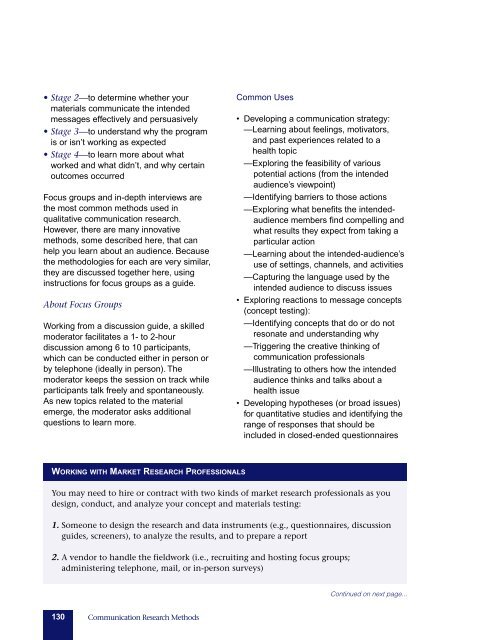pink-book
pink-book
pink-book
Create successful ePaper yourself
Turn your PDF publications into a flip-book with our unique Google optimized e-Paper software.
• Stage 2—to determine whether your<br />
materials communicate the intended<br />
messages effectively and persuasively<br />
• Stage 3—to understand why the program<br />
is or isn’t working as expected<br />
• Stage 4—to learn more about what<br />
worked and what didn’t, and why certain<br />
outcomes occurred<br />
Focus groups and in-depth interviews are<br />
the most common methods used in<br />
qualitative communication research.<br />
However, there are many innovative<br />
methods, some described here, that can<br />
help you learn about an audience. Because<br />
the methodologies for each are very similar,<br />
they are discussed together here, using<br />
instructions for focus groups as a guide.<br />
About Focus Groups<br />
Working from a discussion guide, a skilled<br />
moderator facilitates a 1- to 2-hour<br />
discussion among 6 to 10 participants,<br />
which can be conducted either in person or<br />
by telephone (ideally in person). The<br />
moderator keeps the session on track while<br />
participants talk freely and spontaneously.<br />
As new topics related to the material<br />
emerge, the moderator asks additional<br />
questions to learn more.<br />
Common Uses<br />
• Developing a communication strategy:<br />
—Learning about feelings, motivators,<br />
and past experiences related to a<br />
health topic<br />
—Exploring the feasibility of various <br />
potential actions (from the intended<br />
audience’s viewpoint)<br />
—Identifying barriers to those actions<br />
—Exploring what benefits the intendedaudience<br />
members find compelling and<br />
what results they expect from taking a<br />
particular action<br />
—Learning about the intended-audience’s<br />
use of settings, channels, and activities<br />
—Capturing the language used by the<br />
intended audience to discuss issues<br />
• Exploring reactions to message concepts<br />
(concept testing):<br />
—Identifying concepts that do or do not<br />
resonate and understanding why<br />
—Triggering the creative thinking of<br />
communication professionals<br />
—Illustrating to others how the intended<br />
audience thinks and talks about a<br />
health issue<br />
• Developing hypotheses (or broad issues)<br />
for quantitative studies and identifying the<br />
range of responses that should be<br />
included in closed-ended questionnaires<br />
WORKING WITH MARKET RESEARCH PROFESSIONALS<br />
You may need to hire or contract with two kinds of market research professionals as you<br />
design, conduct, and analyze your concept and materials testing:<br />
1. Someone to design the research and data instruments (e.g., questionnaires, discussion<br />
guides, screeners), to analyze the results, and to prepare a report<br />
2. A vendor to handle the fieldwork (i.e., recruiting and hosting focus groups;<br />
administering telephone, mail, or in-person surveys)<br />
Continued on next page...<br />
130 Communication Research Methods


